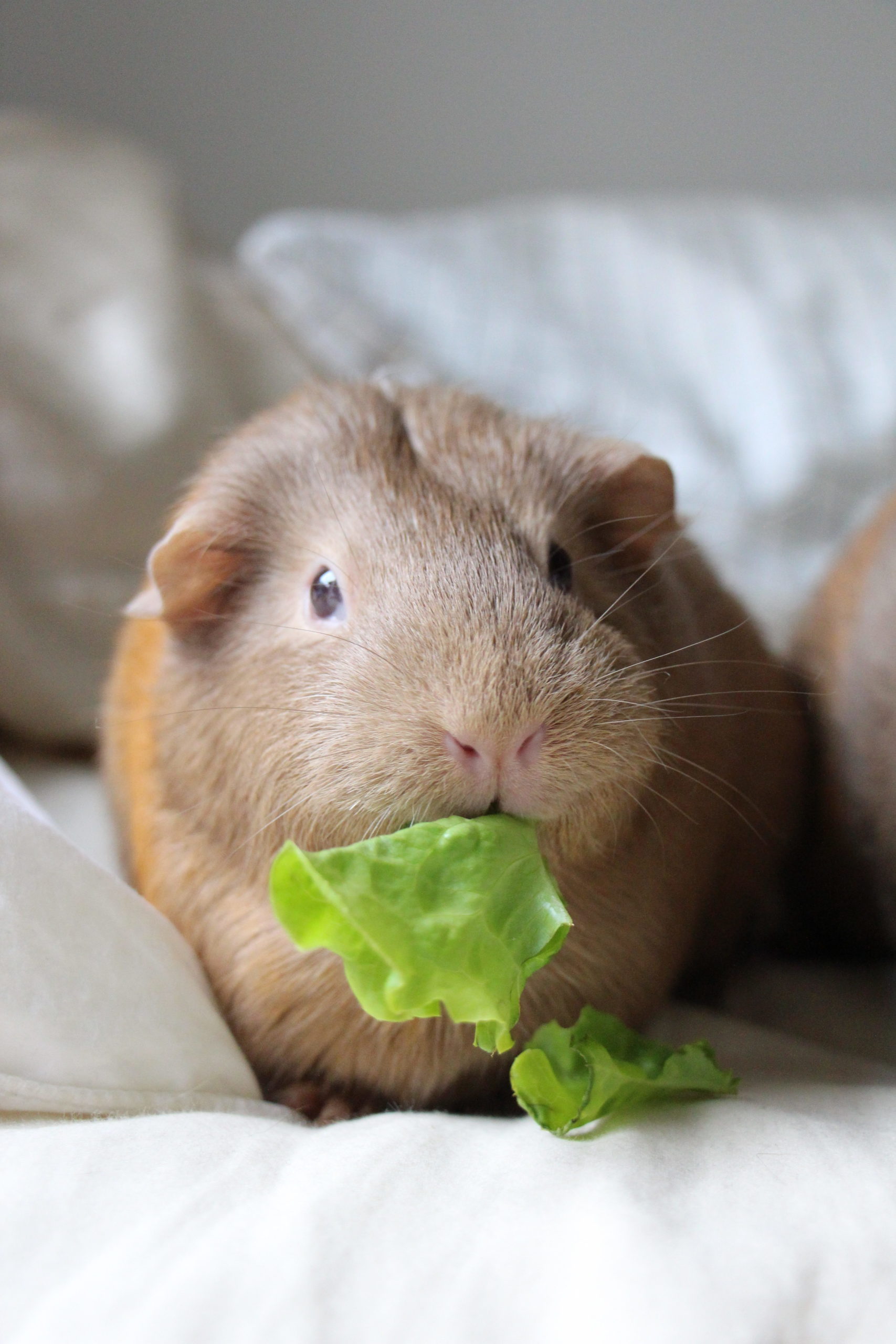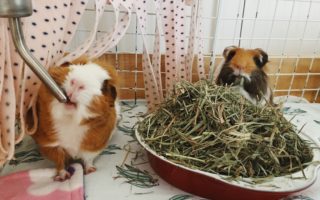What can my Guinea Pig eat?
Guinea pigs can eat a huge variety of fruits, vegetables, herbs and other plants however hay should make up the majority of their diet. Hay is an essential in your guinea pigs diet as it provides the much needed fiber, protein and roughage that a healthy guinea pig requires to maintain a healthy . Timothy hay is a great hay to supply for your guinea pig as it contains the right balance of fiber, protein and carbohydrates and can be eaten throughout all stages of a guinea pigs life.
Fresh grass is a great food in a guinea pigs diet as it can be consumed in large amounts and is great for their digestive system. If you don’t have grass in your yard – don’t worry! Wheatgrass, the freshly sprouted leaves of the wheat plant, can be easily grow indoors and is a great alternative to backyard grass for your guinea pig. When selecting grass for your guinea pig you should select fresh grass that you know hasn’t been sprayed with any chemicals. Lawn clippings should never be given to your guinea pig in substitute for grass, as they may contain harmful debris or toxic plants.
Pellets are an excellent addition to your guinea pigs diet, however not all pellets marketed towards guinea pigs are suitable or healthy. When choosing a pellet for your guinea pig look for something that is timothy hay based instead of alfalfa, and ensure there are no nuts or seeds in the mixture as they can be choking hazards and are too rich in fat.
Fresh vegetables may be fed to your guinea pig daily, however fruits should be treated as treats and fed sparingly. One cup of fresh fruits and vegetables is allowed per guinea pig per day as over consumption of vegetables and especially fruits can cause diarrhea or digestive upset.
Below is a list of several fruits, vegetables, plants and herbs that guinea pigs enjoy eating as well as a list of toxic foods for guinea pigs.
Small Amounts: about 2cm thick slices
Feed Occasionally: 2 – 4 times a week in small portions (best spaced several days apart)
Feed Rarely: Once a month at most
VEGETABLES:
While vegetables are an important staple in a guinea pigs diet, not all vegetables are suited for daily feeding. Leafy greens should make up the bulk of your guinea pigs vegetable intake, but there are a variety of other vegetables that your guinea pig will enjoy too. All new foods should be introduced gradually and in small amounts to prevent digestive problems. Guinea pigs should be allowed one cup of fresh veggie per pig per day and all vegetables should be served raw.
- Asparagus – Fed rarely but can be a special treat
- Beetroot – Beetroot and its leaves can be fed in small amounts as a treat due to the oxialic acid content. May take colour on urine or stools
- Broccoli – High amounts of Vitamin C but can cause gas in large amounts, introduce slowly and only feed occasionally
- Brussel Sprouts – Can be hard to digest and may cause gas in excess amounts, feed sparingly
- Carrot – Calorie dense and shouldn’t be fed everyday but can be fed often
- Cabbage – Feed sparingly as excess amounts can cause gas and bloat, remember to introduce foods slowly – especially foods that can cause gas
- Capsicum – Also known as bell pepper, red capsicum is one of the best ways for your guinea pig to get vitamin C. Can be fed daily.
- Celery – Chop stem into small pieces to prevent choking. The leaves can be rich in calcium so should be fed in small amounts, or none at all to guinea pigs prone to bladder infections.
- Corn – Fresh corn as well as its husk can be eaten but don’t allow your guinea pig to eat the cob. Tinned or frozen corn can not be used
- Cucumber – Very popular among guinea pigs and a good staple to promote hydration but can cause diarrhea in excess amounts
- Endive – Rich in vitamins and minerals, leafy
- Fennel – Rich in vitamins and minerals and may take a colour on urine,
- Kale – High in vitamin A and should be fed sparingly
- Lettuce – Can cause diarrhea in large amounts. Do not feed your guinea pig Iceburg lettuce
- Pak Choy – High in vitamin C
- Pumpkin – Rich in vitamin A but should be fed as a treat
- Rutabaga – Rich in vitamins
- Spinach – Due to high oxialic acid and calcium content, spinach should be fed sparingly
- Sweet Potato – A rare treat that is high in starch and sugar. May be fed with peel
- Tomato – Both large and small tomatoes are safe to eat but should be fed in small amounts to prevent mouth sores as well as digestive upset. When tomato is fed often together with spinach, it can lead to bladder stones due to their high mineral content
- Turnip – High in sugar but can be fed occasionally
- Zucchini – Some guinea pigs don’t like the taste, but it can be fed occasionally
FRUITS:
Fruits should be considered a treat for guinea pigs and should be fed in small amounts, once a week is a good frequency. Over-consumption of fruits can cause weight gain, diabetes, diarrhea and other health issues in guinea pigs.
- Apple – A tasty fruit that many guinea pigs enjoy, remove core and all seeds prior to feeding
- Banana – Rich in sugar and should be fed rarely. May cause constipation and should not be fed to guinea pigs with diabetes
- Grapes – Feed rarely, removing skin, leaves and stems
- Kiwi Fruit – Rich in vitamin C but can cause mouth sores. Feed rarely, if at all
- Melon – Rich in sugar but is a tasty treat
- Orange & Mandarin – Rich in sugars and can irritate the mouth. Feed rarely in small amounts
- Pear – Rich in sugars and may cause constipation. Feed in small amounts as a treat.
- Rose Hip – Provide shells only. Fresh or dry, rich in vitamin C
- Strawberries – May be fed with the green leaves
HERBS & PLANTS:
- Alfalfa – May only be provided fresh and in small amounts
- Basil – Provided fresh but feed sparingly
- Caraway – Rich in vitamins however may take a colour on urine
- Chamomile – Sweet and tasty, can be fed dried or fresh
- Sage – Fed rarely in small amounts
- Coriander – Medium calcium and vitamin C content but can be fed frequently
- Dandelion – Can be eaten in moderation including stems, flowers and leaves
- Dill – May be consumed rarely in small amounts
- Grass – Picked fresh, can be fed in large amounts daily alongside hay and water. If seasonal, slowly introduce fresh grass back into your guinea pigs diet to prevent diarrhea
- Lavender – Sweet, tasty and can be fed both dry and fresh
- Mint – Can be fed dry or fresh in small amounts. Should not be fed to breast feeding or pregnant guinea pigs
- Oregano – Very high in calcium and should be fed very rarely, if at all. One – two leaves at most
- Parsley – High in calcium but a tasty treat. Should be fed sparingly but not to milk producing or pregnant guinea pigs
BRANCHES & LEAVES:
Your guinea pig will enjoy foraging and munching on the stems and leaves you might find in your backyard. Ensure you correctly identify the plant before giving it to your guinea pig to eat and only feed them fresh plants that you know haven’t been sprayed with chemicals. All plants should be washed and pest free before being provided to your guinea pig.
- Apple – Can be fed in large amounts, leaves and stems included
- Cherry – Sweet and tasty, a favourite among guinea pigs
- Hazelnut – A much loved branch that can be provided in large amounts
- Pear – Large amounts may be provided
- Willow – Can be fed in large amounts, stems and leaves included
TOXIC FOODS FOR GUINEA PIGS:
- Potatoes – contain toxins which are harmful for guinea pigs. Do not feed any part of the plant, peel or potato itself
- Cabbage – in large, frequent amounts can cause gas and bloat which can be lethal for guinea pigs
- Onions, garlic and bulbous plants as well as anything to do with the plant
- Beans and legumes as well as anything to do with the plant
- Avocado – too rich in fat which can cause digestive problems. The skin itself is toxic and should not be consumed
- Rhubarb – extremely toxic and can be lethal within minutes
- Excess Fruit – can cause diarrhea, diabetes, bloat as well as other health issues which can be fatal
- Oak – None of this plant matter should be consumed including the stem, barks and leaves
- Tomato Plants – highly toxic to guinea pigs however the fruit may be safely consumed
- Unidentified Plants & Leaves – if you are unsure what a plant is, do not feed it to your guinea pig
- Frozen Vegetables – guinea pigs should consume their fruit and vegetables in their natural state.
- Seeds and Nuts – while being rich in fat and oils, seeds and nuts can also act as a choking hazard
- Caffeine – This includes coffee, teas, energy and soft drinks. While some teas don’t have caffeine, it’s best not to give your guinea pig anything they would not naturally eat.
- Processed Foods – This includes all pre-made, cooked and processed foods. Your guinea pig should only be eating hay, water, pellets and fresh fruit and vegetables.
Your guinea pig should always have access to fresh hay and water. Do not add anything to your guinea pigs water. Vitamin C drops or powers marketed towards rodents and guinea pigs are not to be used in their water as not only can it deter them from drinking, but Vitamin C is water soluble and will degrade rapidly once introduced to water. Fresh fruit, vegetables, hay and grass have all the nutrients that your guinea pig needs.
Follow this link for more information on guinea pigs diet and nutrition.

